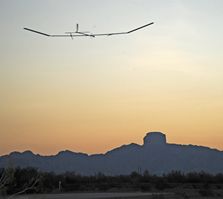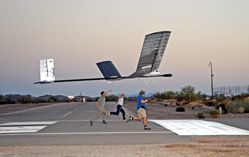|
Longest unmanned flight-Zephyr sets world record
ARIZONA, USA -- The Zephyr, a solar powered high-altitude
long-endurance (HALE) Unmanned Aerial Vehicle (UAV), created
by UK defence and research firm QinetiQ,
remained in the air for 83 hours and 37 minutes, setting a
new world record for Longest unmanned flight.
Photo: The flight
trial at Yuma took place between 28 and 31 July in the harsh
conditions of the Sonoran Desert in mid summer with temperatures
up to 45°C (113°F). Zephyr was flown on autopilot and via
satellite communications to a maximum altitude of more than
60,000ft. (enlarge
photo)
Launched by hand, Zephyr is an ultra-lightweight
carbon-fibre aircraft. By day it flies on solar power generated
by amorphous silicon solar arrays no thicker than sheets of
paper that cover the aircraft's wings. By night it is powered
by rechargeable lithium-sulphur batteries, supplied by SION
Power Inc, which are recharged during the day using solar
power.
The trial included a military utility assessment
of a US Government communications payload.
The flight beats the current official
world record of 30 hours, 24 minutes set by the US robot plane
Global Hawk in 2001 and the Zephyr's own previous
record of 54 hours. 
Photo: Zephyr has a carbon fibre
frame and is covered in super-light solar arrays thinner than
paper. Its rechargeable battery is twice as efficient as any
other in the world. It is launched by three people holding
it above their heads as they run. (enlarge
photo)
Simon Bennett, Managing Director of QinetiQ's
Applied Technologies business said: "The Yuma Proving Ground
in Arizona was an appropriate setting for Zephyr's world beating
flight as many landmark aviation developments have taken place
there in recent years. In addition to setting a new unofficial
record, the trial is a step towards the delivery of Zephyr's
capability for joint, real-time, battlefield persistent surveillance
and communications to forces in the field at the earliest
opportunity."
The Ministry of Defence has funded the
£20m development of Zephyr so far. The flight - partly autonomous
and partly controlled from satellite - took place from July
28-31.
Davey said the challenge had been to make an
exceptionally light aircraft - it weighs 30kg (66lbs) - strong
enough to carry a payload of up to 2kg to about 60,000ft.
The 30kg plane has an 18-metre wingspan,
looks like a giant model aircraft and is launched by hand.
Potential applications for Zephyr include
earth observation and communications relay in support of a
range of defence, security and civil requirements.
Hampshire-based QinetiQ
are now working with aerospace giant Boeing on a defence project
that would see the biggest solar-powered plane in history
take to the sky.
The firm is also looking at civilian uses for
the unmanned craft and recently completed the first flight
for agricultural monitoring, in partnership with Aberystwyth
University.
The solar powered plane flew for 82
hours 37 minutes, exceeding the current official world record
for unmanned flight which stands at 30 hours 24 minutes set
by Global Hawk in 2001 and Zephyr's previous
longest flight of 54 hours achieved last year.
Photos: QinetiQ/HO
Monday, August 25, 2008
|
















